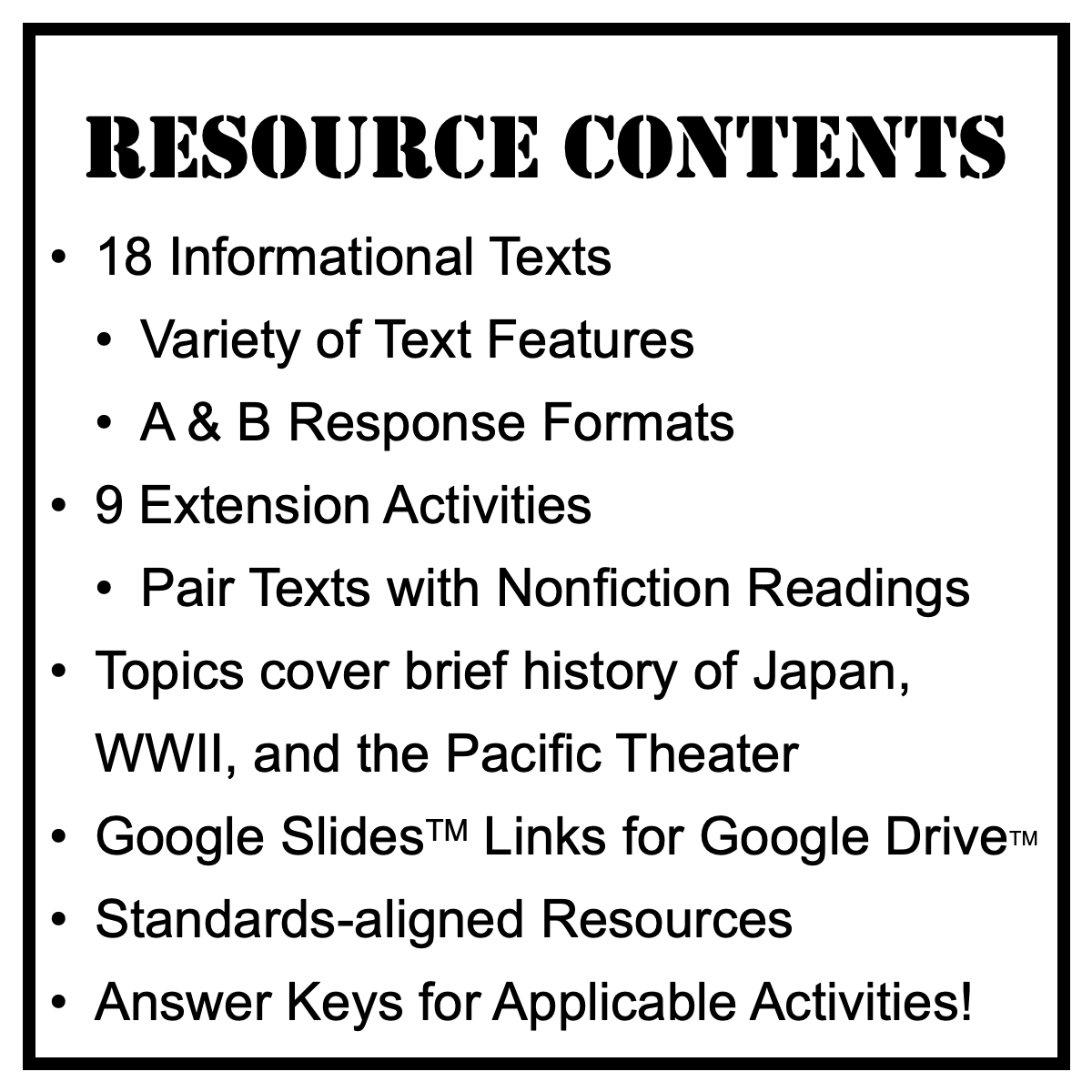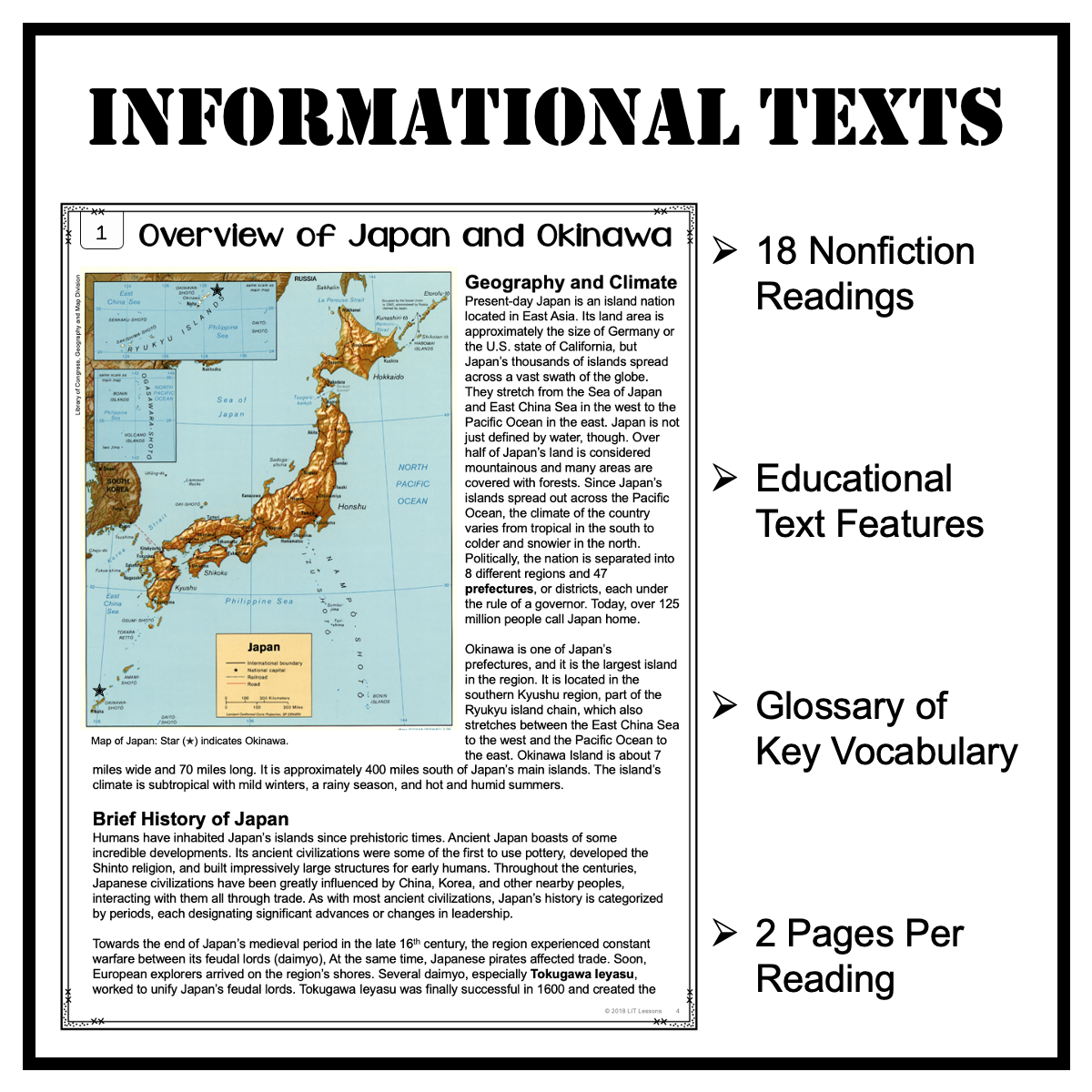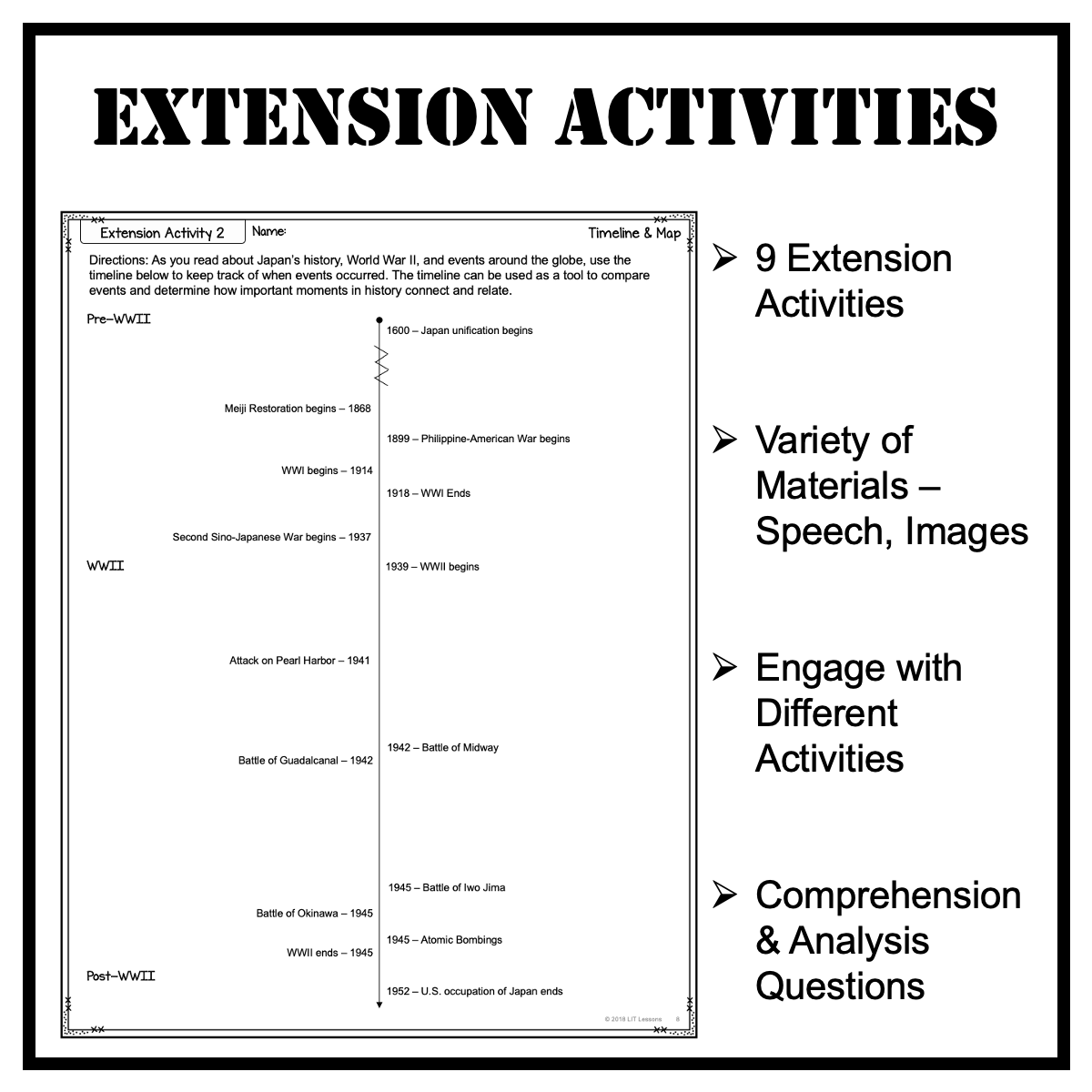Grenade WWII Pacific Theater Readings & Activities
You can only add to a wishlist if you have an account, please register now.
Create an Account$12
Grenade WWII Nonfiction Connections – Snapshot of Included Resources:
- 18 Informational Texts
- Variety of Text Features
- A & B Response Formats
- 9 Extension Activities
- Pair Texts with Nonfiction Readings
- Topics cover brief history of Japan, WWII, and the Pacific Theater
- Google Slides™ Links for Google Drive™
- Standards-aligned Resources
- Answer Keys for Applicable Activities!
-
Citing textual evidence to support analysis of the text
-
Identifying and analyzing text features
-
Summarizing the main idea of a text with supporting details
-
Determining the meaning of words or phrases as used in the text
-
Determining author’s purpose and its effects
-
Identifying and analyzing arguments and specific claims in a text
-
Identifying and analyzing text structure and its effects
-
Addressing Offensive Language: The word “Jap” can be found in Grenade and throughout documents created during the World War II era. It is critical students understand that the word is offensive and should not be used. This activity will help them understand the term’s gravity and help prepare them to thoughtfully treat it when it is encountered.
-
Timeline & Map: A timeline is provided in each nonfiction article for students to reference. The timeline can help students place events and help them understand how individual occurrences relate to global events. The extension activity timeline is a compilation of the nonfiction articles’ timelines in its entirety.
-
Political Cartoons & U.S. Expansionism: In this activity, students will analyze political cartoons about American expansionism. Then, they will research the Philippine-American War in order to draw a cartoon from the Filipino perspective, allowing them to examine the historical tensions in the region from multiple perspectives.
-
War Ships & War Games: Students will play a game to learn about the basics of five different naval ships. It is an engaging way to build background knowledge about the names and labels students will often encounter when learning about naval warfare.
-
The Infamy Speech: For this extension activity, students will compare and contrast Roosevelt’s “Infamy Speech” with his rough draft for it. This activity is a fantastic close reading exercise that will really help students see the impact of word choice on tone, argument, and theme.
-
The Pacific War in Color: In the documentary viewing, students will learn more about the island-hopping strategy of the Pacific Theater. The episodes also contain rich information about other aspects of the war that will provide a more macro view of the conflict. *Episodes not included in this resource.*
-
Breaking an Unbreakable Code: For this activity, students will work with the Navajo Code Talkers Dictionary to break codes and learn more about the lives of code talkers. Then, students will encode and decode messages with their classmates. Ultimately, they will come to understand how code talkers made valuable contributions to the war effort.
-
Image Study of the Atomic Bombings: Students will study five images of the aftermath of the atomic bombing of Hiroshima and Nagasaki. As they examine the images, students will think critically about the bombing’s purpose, immediate effects, and ultimate legacy.
-
Interment – Orders & Apologies: For the final extension activity, students will engage in a close reading of Executive Order 9066, the Civil Liberties Act of 1988, and proposed amendments to the act. Students will analyze language to discern meaning, intent, and the values being conveyed as they consider whether government action reflects stated ideals.
- ZIP file (PDFs and Word Docs for Digital Links)
- Non-Editable
- 81.49 MB
- 205 Pages
- Links for Student Pages in Google Slides™ & Google Forms™
- This downloadable resource supplies one single-teacher license for use in your classroom.
- Photocopying of this product is allowed only for the classroom use of the purchaser.
- Replication of this product, in whole or in part, for commercial sale or broader distribution is strictly prohibited.
- This product also may NOT be shared electronically, digitally, or otherwise in a manner that violates the Terms of Use detailed by LIT Lessons.
- For explicit information on permissions, please see the Terms of Use document included with this resource. Thank you for your cooperation and understanding.
Grenade WWII Nonfiction Connections – Snapshot of Included Resources:
- 18 Informational Texts
- Variety of Text Features
- A & B Response Formats
- 9 Extension Activities
- Pair Texts with Nonfiction Readings
- Topics cover brief history of Japan, WWII, and the Pacific Theater
- Google Slides™ Links for Google Drive™
- Standards-aligned Resources
- Answer Keys for Applicable Activities!
-
Citing textual evidence to support analysis of the text
-
Identifying and analyzing text features
-
Summarizing the main idea of a text with supporting details
-
Determining the meaning of words or phrases as used in the text
-
Determining author’s purpose and its effects
-
Identifying and analyzing arguments and specific claims in a text
-
Identifying and analyzing text structure and its effects
-
Addressing Offensive Language: The word “Jap” can be found in Grenade and throughout documents created during the World War II era. It is critical students understand that the word is offensive and should not be used. This activity will help them understand the term’s gravity and help prepare them to thoughtfully treat it when it is encountered.
-
Timeline & Map: A timeline is provided in each nonfiction article for students to reference. The timeline can help students place events and help them understand how individual occurrences relate to global events. The extension activity timeline is a compilation of the nonfiction articles’ timelines in its entirety.
-
Political Cartoons & U.S. Expansionism: In this activity, students will analyze political cartoons about American expansionism. Then, they will research the Philippine-American War in order to draw a cartoon from the Filipino perspective, allowing them to examine the historical tensions in the region from multiple perspectives.
-
War Ships & War Games: Students will play a game to learn about the basics of five different naval ships. It is an engaging way to build background knowledge about the names and labels students will often encounter when learning about naval warfare.
-
The Infamy Speech: For this extension activity, students will compare and contrast Roosevelt’s “Infamy Speech” with his rough draft for it. This activity is a fantastic close reading exercise that will really help students see the impact of word choice on tone, argument, and theme.
-
The Pacific War in Color: In the documentary viewing, students will learn more about the island-hopping strategy of the Pacific Theater. The episodes also contain rich information about other aspects of the war that will provide a more macro view of the conflict. *Episodes not included in this resource.*
-
Breaking an Unbreakable Code: For this activity, students will work with the Navajo Code Talkers Dictionary to break codes and learn more about the lives of code talkers. Then, students will encode and decode messages with their classmates. Ultimately, they will come to understand how code talkers made valuable contributions to the war effort.
-
Image Study of the Atomic Bombings: Students will study five images of the aftermath of the atomic bombing of Hiroshima and Nagasaki. As they examine the images, students will think critically about the bombing’s purpose, immediate effects, and ultimate legacy.
-
Interment – Orders & Apologies: For the final extension activity, students will engage in a close reading of Executive Order 9066, the Civil Liberties Act of 1988, and proposed amendments to the act. Students will analyze language to discern meaning, intent, and the values being conveyed as they consider whether government action reflects stated ideals.
- ZIP file (PDFs and Word Docs for Digital Links)
- Non-Editable
- 81.49 MB
- 205 Pages
- Links for Student Pages in Google Slides™ & Google Forms™
- This downloadable resource supplies one single-teacher license for use in your classroom.
- Photocopying of this product is allowed only for the classroom use of the purchaser.
- Replication of this product, in whole or in part, for commercial sale or broader distribution is strictly prohibited.
- This product also may NOT be shared electronically, digitally, or otherwise in a manner that violates the Terms of Use detailed by LIT Lessons.
- For explicit information on permissions, please see the Terms of Use document included with this resource. Thank you for your cooperation and understanding.



More Grenade Resources...
Grenade Novel Study
The Grenade Novel Study is a comprehensive set of standards-aligned instructional materials for teaching Grenade by Alan Gratz. With over 100+ materials, students will deeply engage with the novel and develop their literacy skills. The close reading activities, literary analysis resources, WWII Pacific Theater nonfiction readings and activities, vocabulary, assessments, and final projects all provide opportunities for your students to practice and apply what will be their growing understanding of the novel. They also provide numerous ways for you to DIFFERENTIATE learning for your students, allowing you to choose the assignments that best support your students’ learning while being conducive to any classroom model.
Grenade Reading Response Resource
The comprehension and literary analysis resources for Alan Gratz’s Grenade will give students repeated opportunities to practice essential literacy skills aligned to the Common Core State Standards. For every chapter grouping, students will have to answer rigorous, text-based questions that assess not only their ability to comprehend but also their ability to analyze key events. With numerous options for implementation, the resource also allows for differentiation and can enable accommodation that will meet the needs of all learners. There are two sets of questions for each reading: Reading Response A (comprehension) and Reading Response B (analysis). The twin sets offer different levels of challenge for students to give you options for meeting the needs of all your learners. All 36 assignments include questions that require close reading of the text, which means your students will always be practicing essential skills.
Grenade Close Readings
The 18 close reading lessons explicitly focus on critical Common Core State Standards to develop students’ literacy proficiency. Using Grenade as the foundational text for close reading, each lesson focuses on a particular skill, such as setting, conflict, tone, and plot, and provides students an opportunity to develop and demonstrate their ability to perform that skill. Each assignment also requires students to use textual evidence to support their claims. The resources could supply homework, facilitate guided reading groups, or stimulate whole class literacy discussions for each chapter grouping. You can choose the purpose that best suits your students and your classroom.
Grenade Assessments
The standards-aligned assessments will help you measure your students’ comprehension of Grenade and their ability to apply the literary skills taught throughout the unit. The materials include 18 reading checks, 2 novel quizzes, 3 final assessments, and essay prompts.
Grenade Vocabulary
The vocabulary resources will engage students in varied activities to expand their vocabulary. The resources include materials to help teach challenging vocabulary words in Grenade that will then build your students’ vocabulary. With 6 vocabulary lists of 10 words each and a crossword puzzle and quiz for each set, the materials provide opportunities for differentiation to suit the needs of the classroom.
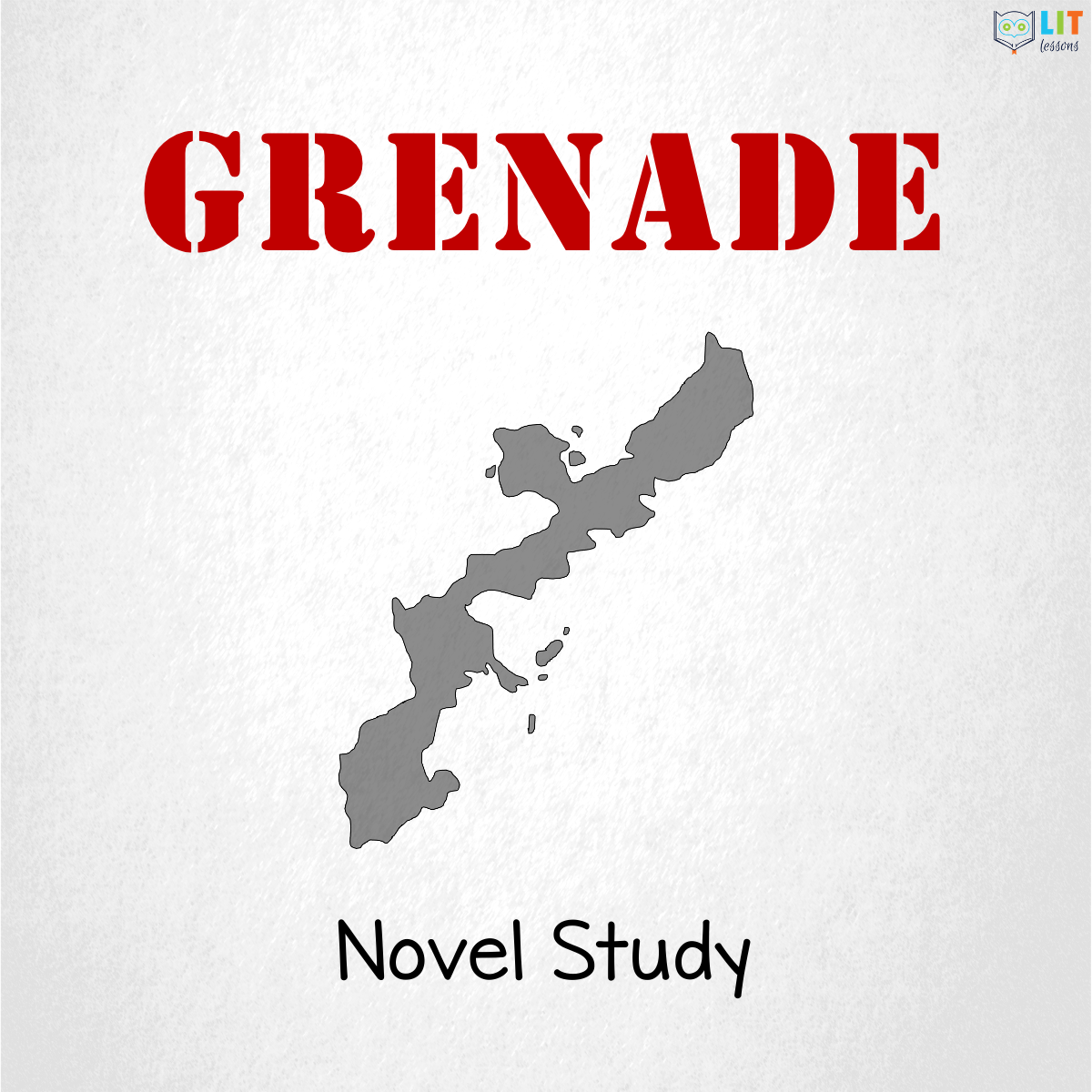
Grenade Novel Study
The Grenade Novel Study is a comprehensive set of standards-aligned instructional materials for teaching Grenade by Alan Gratz. With over 100+ materials, students will deeply engage with the novel and develop their literacy skills. The close reading activities, literary analysis resources, WWII Pacific Theater nonfiction readings and activities, vocabulary, assessments, and final projects all provide opportunities for your students to practice and apply what will be their growing understanding of the novel. They also provide numerous ways for you to DIFFERENTIATE learning for your students, allowing you to choose the assignments that best support your students’ learning while being conducive to any classroom model.

Grenade Reading Response Resource
The comprehension and literary analysis resources for Alan Gratz’s Grenade will give students repeated opportunities to practice essential literacy skills aligned to the Common Core State Standards. For every chapter grouping, students will have to answer rigorous, text-based questions that assess not only their ability to comprehend but also their ability to analyze key events. With numerous options for implementation, the resource also allows for differentiation and can enable accommodation that will meet the needs of all learners. There are two sets of questions for each reading: Reading Response A (comprehension) and Reading Response B (analysis). The twin sets offer different levels of challenge for students to give you options for meeting the needs of all your learners. All 36 assignments include questions that require close reading of the text, which means your students will always be practicing essential skills.

Grenade Close Readings
The 18 close reading lessons explicitly focus on critical Common Core State Standards to develop students’ literacy proficiency. Using Grenade as the foundational text for close reading, each lesson focuses on a particular skill, such as setting, conflict, tone, and plot, and provides students an opportunity to develop and demonstrate their ability to perform that skill. Each assignment also requires students to use textual evidence to support their claims. The resources could supply homework, facilitate guided reading groups, or stimulate whole class literacy discussions for each chapter grouping. You can choose the purpose that best suits your students and your classroom.

Grenade Assessments
The standards-aligned assessments will help you measure your students’ comprehension of Grenade and their ability to apply the literary skills taught throughout the unit. The materials include 18 reading checks, 2 novel quizzes, 3 final assessments, and essay prompts.
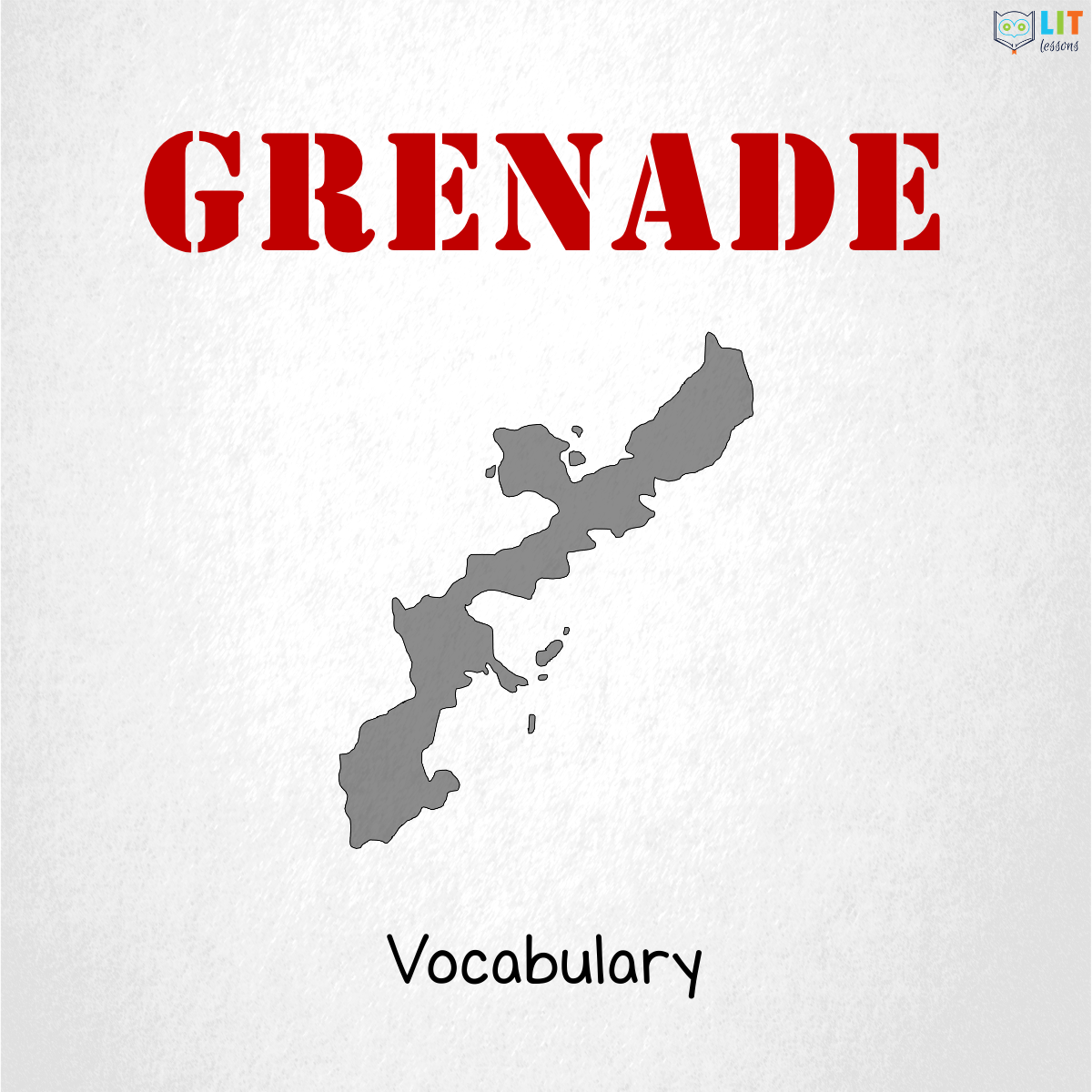
Grenade Vocabulary
The vocabulary resources will engage students in varied activities to expand their vocabulary. The resources include materials to help teach challenging vocabulary words in Grenade that will then build your students’ vocabulary. With 6 vocabulary lists of 10 words each and a crossword puzzle and quiz for each set, the materials provide opportunities for differentiation to suit the needs of the classroom.


